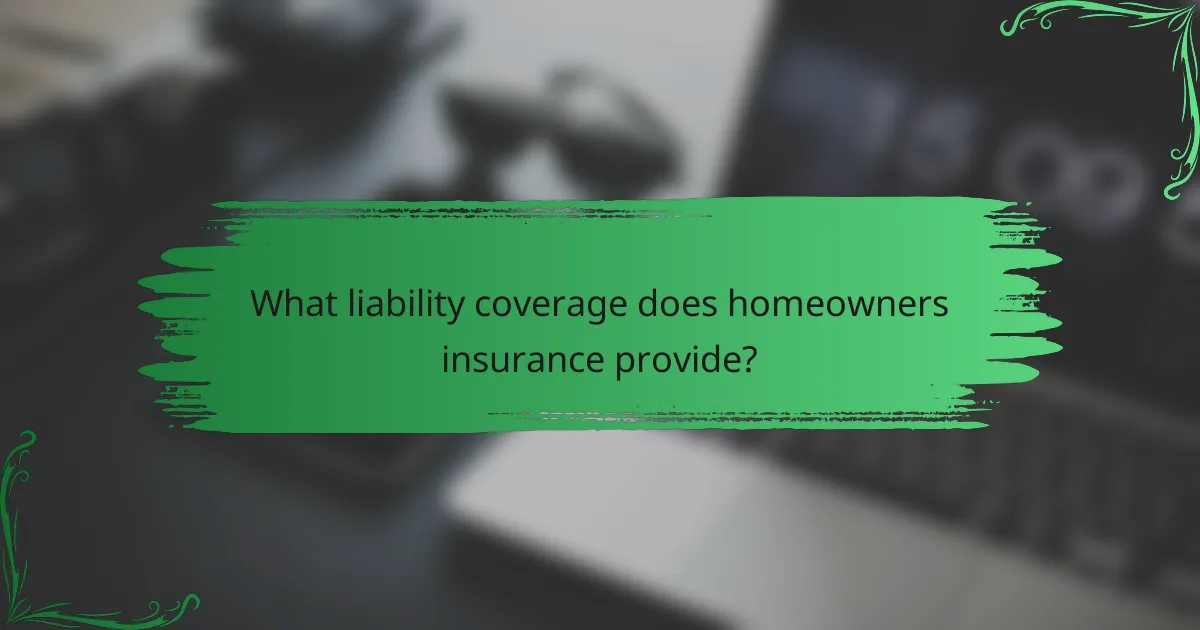Homeowners insurance is essential for safeguarding your property and personal belongings while also providing crucial liability coverage. This insurance not only helps you recover from unexpected events like natural disasters or theft but also protects you from potential legal claims arising from injuries on your property. With the right policy, you can enjoy peace of mind knowing that you are financially secure against various risks. Consider factors such as coverage limits and additional features to find the best option for your needs.

What are the best homeowners insurance options in the UK?
The best homeowners insurance options in the UK typically provide comprehensive property protection and liability coverage, ensuring peace of mind for homeowners. Key factors to consider include coverage limits, premiums, and additional features such as accidental damage or legal expenses.
Aviva Home Insurance
Aviva offers flexible home insurance policies that can be tailored to meet individual needs. Their coverage includes buildings and contents insurance, with options for additional protection against accidental damage and personal belongings outside the home.
One notable feature is the ability to choose between a standard or enhanced policy, which can affect premiums significantly. Homeowners should evaluate their specific requirements to determine the best fit.
Direct Line Home Insurance
Direct Line provides straightforward home insurance with a focus on customer service and claims handling. Their policies cover both buildings and contents, with options for additional coverage such as home emergency assistance.
One advantage of Direct Line is their online quote system, which allows for quick comparisons of coverage options. Homeowners should consider the level of excess they are comfortable with, as this can influence premium costs.
LV= Home Insurance
LV= offers a range of home insurance policies that emphasize value for money and comprehensive coverage. Their policies include features like unlimited buildings cover and up to a specified amount for contents, making them suitable for various property types.
Homeowners can benefit from their multi-policy discount if they combine home insurance with other LV= products. It’s advisable to review the terms carefully, especially regarding any exclusions or limits on specific items.

How does homeowners insurance protect your property?
Homeowners insurance offers vital protection for your property by covering damages to your home and personal belongings, as well as providing liability coverage. This type of insurance helps homeowners recover financially from unexpected events like natural disasters, theft, or accidents on their property.
Coverage for structural damage
Homeowners insurance typically covers structural damage caused by various perils, including fire, storms, and vandalism. This means that if your home suffers significant damage, your policy can help pay for repairs or rebuilding costs, often up to the policy limit.
When selecting a policy, consider the replacement cost coverage, which ensures you can rebuild your home to its original state without depreciation deductions. It’s advisable to regularly review your coverage limits to ensure they reflect current rebuilding costs in your area.
Protection against theft
Homeowners insurance provides protection against theft of personal belongings, which can include furniture, electronics, and jewelry. If items are stolen, your policy can reimburse you for their value, subject to your deductible and coverage limits.
To maximize your protection, keep an inventory of your possessions, including receipts and photographs. Additionally, consider adding a rider for high-value items, as standard policies may have limited coverage for expensive possessions.

What liability coverage does homeowners insurance provide?
Homeowners insurance typically includes liability coverage that protects you against claims resulting from injuries or damages to others on your property. This coverage can help pay for legal fees, medical expenses, and damages awarded in a lawsuit, offering significant peace of mind for homeowners.
Personal liability coverage
Personal liability coverage is a key component of homeowners insurance, designed to protect you if someone is injured on your property or if you accidentally cause damage to someone else’s property. For instance, if a guest slips and falls in your home, this coverage can help pay for their medical bills and any legal costs if they decide to sue.
Typically, personal liability limits range from $100,000 to $500,000, but higher limits are available for those who want extra protection. It’s advisable to assess your assets and potential risks to determine the appropriate level of coverage.
Medical payments to others
Medical payments to others coverage provides a quick way to cover medical expenses for guests injured on your property, regardless of fault. This means if a visitor trips over a loose rug, this coverage can help pay for their immediate medical treatment without the need for a lawsuit.
Coverage limits for medical payments usually range from $1,000 to $5,000. This is often a low-cost addition to your policy and can help prevent small incidents from escalating into larger legal issues. Always review your policy to understand the specific limits and conditions associated with this coverage.

How to choose the right homeowners insurance?
Choosing the right homeowners insurance involves evaluating your property’s value and understanding the features of different policies. Focus on coverage that protects your home and personal belongings while providing liability protection for accidents that may occur on your property.
Assessing property value
Start by determining the replacement cost of your home, which is the amount needed to rebuild it from scratch. This figure should reflect current construction costs and local market conditions, typically ranging from hundreds of thousands to millions of dollars, depending on the area.
Consider conducting a home appraisal or using online calculators that factor in square footage, location, and materials. Ensure that your insurance coverage matches this value to avoid being underinsured, which can lead to significant out-of-pocket expenses in the event of a loss.
Comparing policy features
When comparing homeowners insurance policies, look for key features such as dwelling coverage, personal property coverage, and liability limits. Policies can vary significantly in terms of coverage amounts and deductibles, so it’s crucial to understand what is included and what is excluded.
Evaluate additional options like replacement cost coverage versus actual cash value, which can impact your payout in a claim. Also, consider endorsements for specific items like jewelry or artwork, as these may require additional coverage to ensure full protection.

What factors affect homeowners insurance premiums in the UK?
Homeowners insurance premiums in the UK are influenced by various factors, including property location, claims history, and the overall risk profile of the homeowner. Understanding these elements can help you manage costs and secure the best coverage for your needs.
Location of the property
The location of your property significantly impacts your homeowners insurance premium. Areas with high crime rates or frequent natural disasters typically result in higher premiums due to increased risk. Conversely, homes in low-risk areas may benefit from lower insurance costs.
When evaluating location, consider factors such as proximity to fire services, flood zones, and local crime statistics. For example, properties in urban areas may face higher premiums compared to those in rural settings, reflecting the differences in risk and potential claims.
Claims history
Your claims history plays a crucial role in determining your homeowners insurance premium. If you have a record of multiple claims, insurers may view you as a higher risk, leading to increased premiums. On the other hand, a clean claims history can result in lower rates.
It’s advisable to be mindful of how often you file claims. Even minor claims can accumulate and affect your premium. Consider whether it’s worth filing a claim for small damages or if you can cover the costs out of pocket to maintain a favorable claims history.

What are common exclusions in homeowners insurance?
Common exclusions in homeowners insurance are specific events or damages that are not covered by standard policies. Understanding these exclusions helps homeowners assess their risks and consider additional coverage options.
Flood damage
Flood damage is typically excluded from standard homeowners insurance policies. Homeowners in flood-prone areas may need to purchase separate flood insurance to protect their property from water damage caused by heavy rains, hurricanes, or rising rivers.
Flood insurance is often provided through the National Flood Insurance Program (NFIP) in the United States, and coverage limits can vary significantly. It’s essential to evaluate your property’s flood risk to determine if this additional coverage is necessary.
Wear and tear
Wear and tear refers to the gradual deterioration of property due to regular use and aging, which is not covered by homeowners insurance. This includes issues like peeling paint, worn carpets, or aging appliances that need replacement over time.
Homeowners should perform regular maintenance to prevent wear and tear from leading to larger issues. Keeping records of repairs and maintenance can also help when filing claims for sudden damage caused by other covered perils.

How to file a homeowners insurance claim?
Filing a homeowners insurance claim involves notifying your insurer about damage or loss to your property. This process typically requires you to provide details about the incident and any supporting documentation.
Contacting your insurer
The first step in filing a claim is to contact your insurance company as soon as possible after the incident. Most insurers have a dedicated claims hotline or online portal for this purpose. Be prepared to provide your policy number and a brief description of the damage.
It’s advisable to report the claim within a few days of the incident to ensure timely processing. Delaying your report may complicate your claim or even lead to denial based on policy terms.
Documenting the damage
Thorough documentation is crucial for a successful claim. Take clear photographs of the damage and make a detailed list of affected items, including their estimated value. This evidence will support your claim and help your insurer assess the situation accurately.
Consider keeping receipts or records of any repairs or temporary fixes you make to mitigate further damage. This can demonstrate your proactive approach and may be reimbursable under your policy.

What are the benefits of bundling homeowners insurance with other policies?
Bundling homeowners insurance with other policies, such as auto or life insurance, can lead to significant savings and simplified management of your insurance needs. Many insurers offer discounts for bundled policies, making it a cost-effective choice for homeowners.
Cost Savings
One of the primary benefits of bundling is the potential for cost savings. Insurance companies often provide discounts ranging from 10% to 25% when you combine multiple policies. This can lead to substantial annual savings, especially for homeowners who also need auto or life insurance.
For example, if your homeowners insurance premium is $1,200 annually, bundling it with an auto policy might reduce your total cost by $200 to $300. Always compare the bundled rate with individual policy rates to ensure you are getting the best deal.
Simplified Management
Bundling insurance policies simplifies management by consolidating multiple policies under one provider. This means fewer bills to track and a single point of contact for customer service, making it easier to manage claims and policy updates.
Having all your insurance with one company can streamline communication and reduce the hassle of dealing with multiple insurers. It also allows for easier tracking of coverage limits and renewal dates.
Enhanced Coverage Options
When you bundle policies, insurers may offer enhanced coverage options that are not available with standalone policies. This can include additional liability coverage or special endorsements tailored to your needs.
For instance, bundling might allow you to add coverage for personal property or liability protection at a lower cost than if you purchased these separately. Always review the specific terms and conditions to understand the full benefits of bundled coverage.



